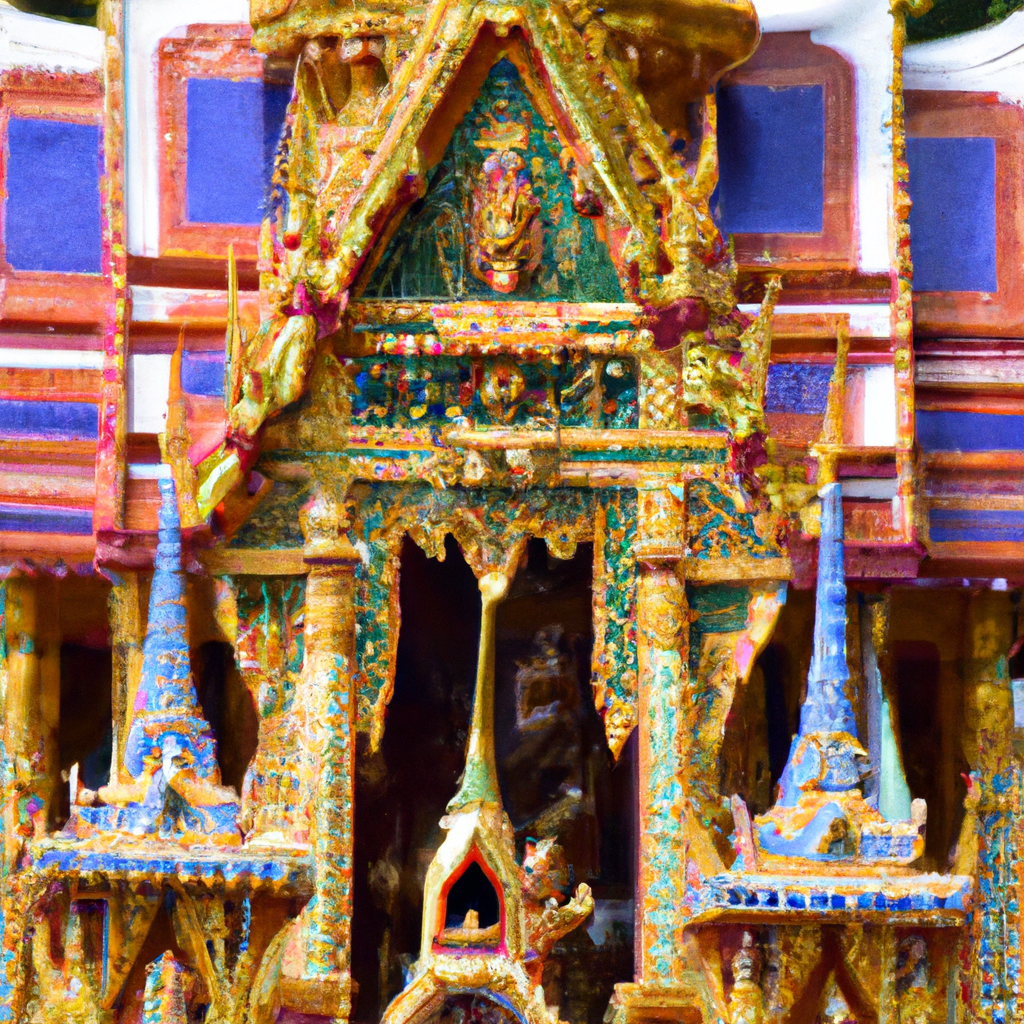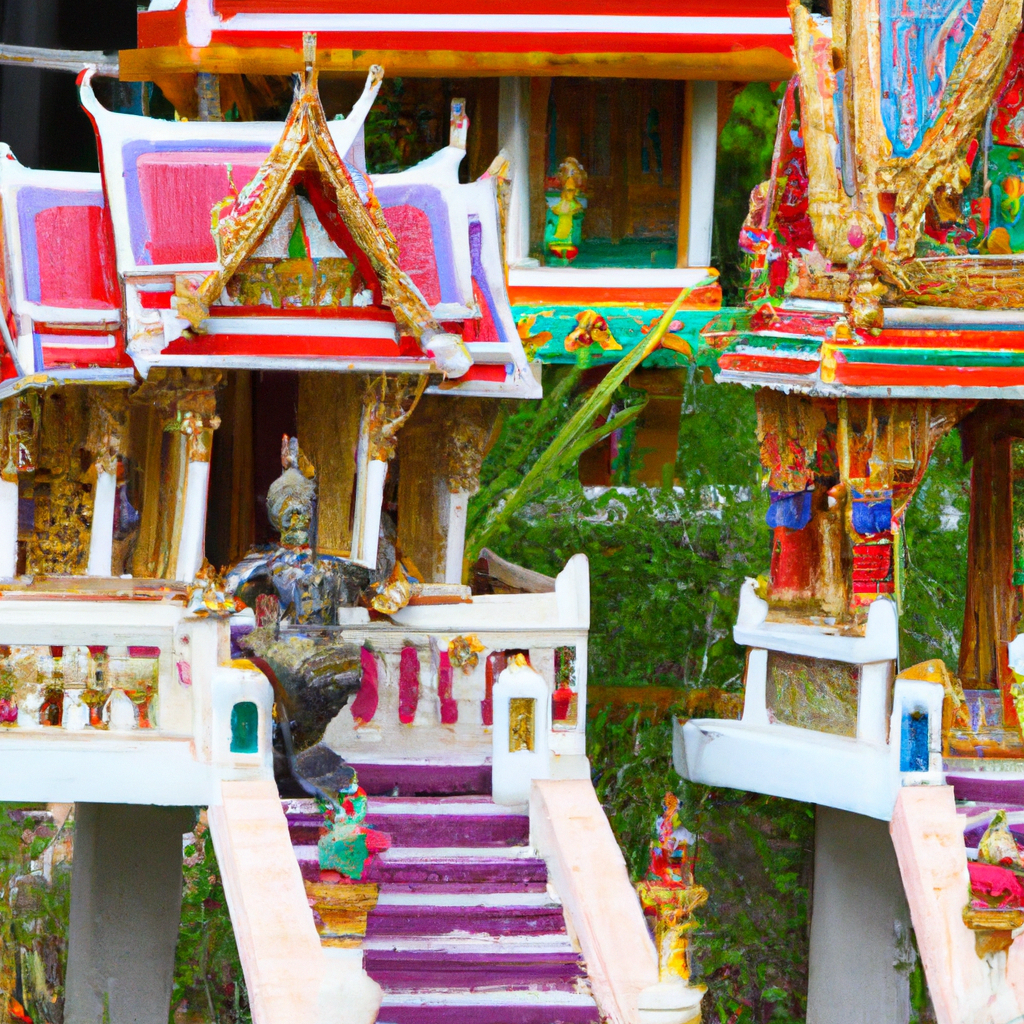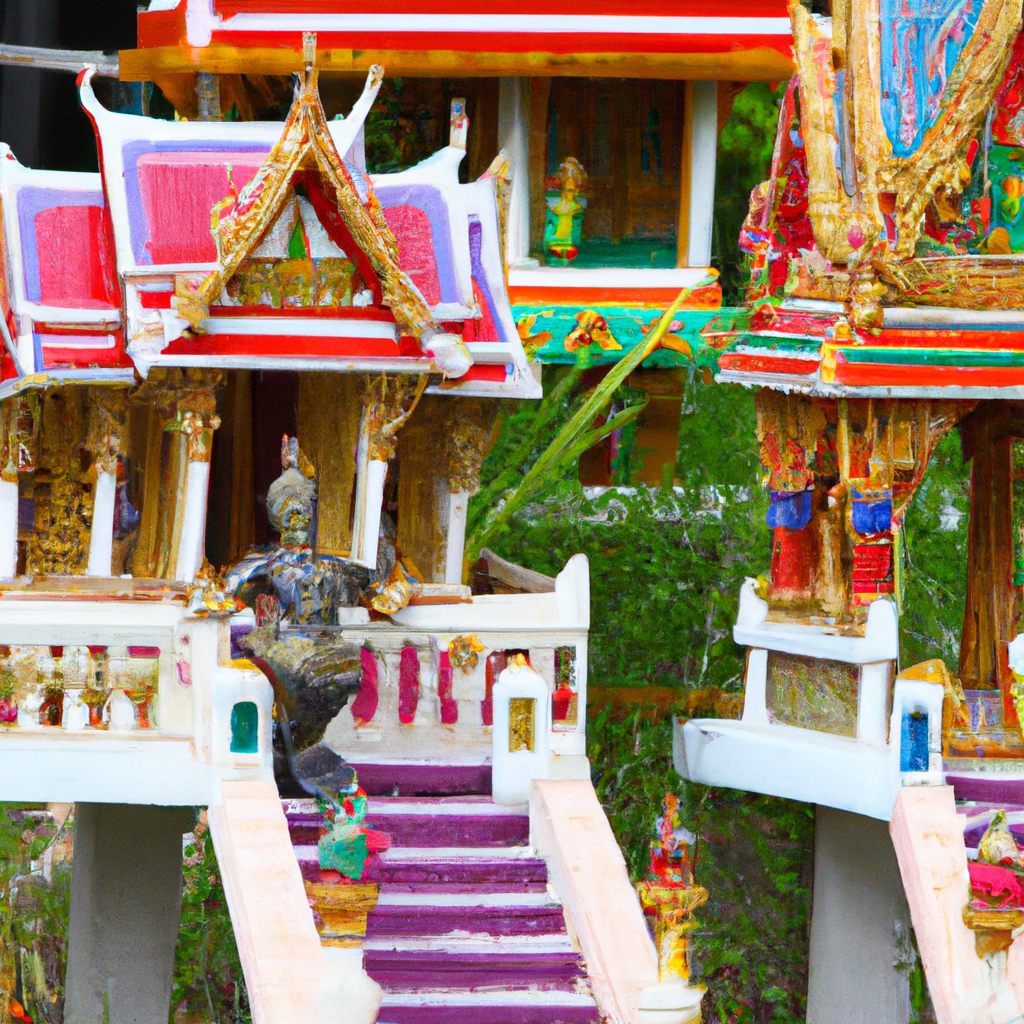Thailand, a land known for its mesmerizing beauty and rich cultural heritage, is home to an enchanting tradition that may make your trip even more captivating – the Spirit Houses. These ornately decorated miniature structures can be seen throughout the country, from bustling cities to tranquil beaches. Providing a sacred space for spirits to dwell and receive offerings, Spirit Houses offer a glimpse into the mystical beliefs of the Thai people. As you explore this unique aspect of Thai culture, prepare to be transported into a world of ancient rituals and deep spirituality.

The Origins of Spirit Houses
Beliefs in Animism and Spirit Worship
The origin of spirit houses in Thailand can be traced back to the country’s deep-rooted beliefs in animism and spirit worship. Animism is the belief that all objects, including natural phenomena and inanimate entities, possess souls or spirits. According to this belief system, spirits play an active role in human lives and can influence the well-being of individuals and communities. In Thai culture, it is believed that spirit houses provide a physical dwelling for these spirits, offering them a place to reside and granting humans the opportunity to interact with them.
Influence of Hinduism and Buddhism
The practice of spirit worship in Thailand has also been influenced by the country’s historical and cultural connections with Hinduism and Buddhism. Hinduism, which arrived in Southeast Asia centuries ago, introduced the concept of spirits and deities that are worshipped and propitiated through offerings. Buddhism, which is the predominant religion in Thailand, absorbed certain elements of spirit worship and incorporated them into its belief system. As a result, spirit houses are commonly found in Buddhist temples and have become an integral part of Thai Buddhism.
The Purpose of Spirit Houses
Providing a Home for Spirits
The primary purpose of spirit houses is to provide a physical abode for the spirits. According to Thai beliefs, these spirits can bring both good fortune and misfortune to humans, depending on their disposition. By offering a separate sanctuary for these spirits, people hope to maintain harmony in their lives and prevent any negative influences. Spirit houses act as a convenient dwelling place for spirits, allowing them to reside close to humans and receive offerings from devotees.
Seeking Protection and Blessings
In addition to providing a home for spirits, spirit houses are also believed to offer protection and blessings to the individuals and communities that maintain them. Thai people often make offerings to the spirits residing in these houses, seeking their favor and assistance in various aspects of life, such as health, wealth, and relationships. The offerings typically include food, drinks, incense, and traditional items believed to be valued by the spirits. By showing their respect and devotion, people hope to receive the spirits’ protection and blessings in return.
Characteristics of Spirit Houses
Architectural Designs
Spirit houses in Thailand are known for their intricate and ornate architectural designs. They are often built in the form of miniature houses, reflecting the traditional Thai architectural style. These structures are typically made of wood, with intricate carvings and decorative elements. The roofs of spirit houses are usually adorned with intricate patterns, while the facades may feature intricate motifs and designs. Many spirit houses are also elevated on a pedestal or platform, symbolizing a separation between the earthly realm and the spiritual realm.
Iconography and Symbolism
Apart from their architectural designs, spirit houses often incorporate various symbols and iconography with profound meaning. These symbols may include depictions of mythical creatures, such as angels and guardian spirits, or representations of Hindu and Buddhist deities. Each symbol holds a specific significance and represents certain qualities or attributes that are associated with the spirit residing in the house. The iconography and symbolism used in spirit houses play a vital role in conveying the religious and cultural beliefs of the Thai people.
Different Types of Spirit Houses
Household Spirit Houses
Household spirit houses are the most common type of spirit houses found in Thailand. They are usually located within the confines of private residences and are dedicated to the protection and well-being of the household members. These spirit houses typically have a central place in the household compound, often positioned in front of the main entrance or within the garden. They are meticulously maintained by the residents, who regularly make offerings and perform rituals to appease and communicate with the spirits.
Public Spirit Houses
Public spirit houses are widely seen in various public spaces throughout Thailand. These spirit houses are typically larger and more elaborate than household spirit houses, as they cater to a broader community. Public spirit houses can be found in parks, markets, schools, and even along the streets. They serve as a focal point for public gatherings, religious ceremonies, and other communal activities. Just like household spirit houses, public spirit houses are maintained by the local authorities or community members who make offerings on behalf of the public.
Temple Spirit Houses
Spirit houses are also an integral part of Buddhist temples in Thailand. Temple spirit houses, known as “san phra phum,” are often located within the temple grounds and are dedicated to the spirits believed to protect the temple and its surroundings. These spirit houses are usually larger in size and more grand in design compared to other types. They play a significant role in temple rituals and ceremonies, with monks and devotees making regular offerings to the spirits residing in the temple spirit houses.

Finding Spirit Houses in Thailand
In the Streets and Alleys
One of the fascinating aspects of spirit houses in Thailand is their ubiquity. They can be found in almost every corner of the country, from bustling cities to remote villages. As you explore the streets and alleys of Thailand, you will undoubtedly come across numerous spirit houses scattered throughout the urban landscape. These spirit houses are often nestled between buildings, along sidewalks, or even integrated into the infrastructure. They serve as a reminder of the deeply ingrained spiritual beliefs and practices within Thai society.
Within Residential Areas
Residential areas in Thailand also provide ample opportunities to encounter spirit houses. As you stroll through neighborhoods, you will notice these miniature houses adorning the front yards or gardens of homes. Thai people take great pride in their spirit houses, ensuring that they are well-maintained and beautifully decorated. The devotion shown towards these spiritual abodes reflects the reverence and respect that Thai people hold for the spirits and their potential influence on their daily lives.
Exploring Significant Spirit Houses
The Erawan Shrine in Bangkok
One of the most famous and significant spirit houses in Thailand is the Erawan Shrine, located in Bangkok. This iconic shrine is dedicated to the four-faced Brahma deity and is believed to bring good fortune and protection to those who pay homage. The Erawan Shrine is always bustling with activity, with devotees offering flowers, incense, and other offerings to the deity. Visitors can witness traditional Thai dance performances and religious rituals, creating a vibrant and enchanting atmosphere around the shrine.
The San Lak Muang in Chiang Mai
Another noteworthy spirit house is the San Lak Muang, situated in Chiang Mai. This spirit house is particularly significant as it is believed to house the city pillar deity, known as Inthakhin or Lak Muang. The pillar is considered the spiritual center of the city and is revered for its protective powers. The San Lak Muang spirit house is an important pilgrimage site and attracts both locals and tourists seeking blessings and guidance. Visitors can witness traditional ceremonies conducted by Buddhist monks, providing a deeper understanding of Thai spiritual traditions.
Spirit House Rituals and Offerings
Making Offerings to Appease Spirits
In Thai culture, performing rituals and making offerings to appease the spirits is an integral part of spirit house traditions. These rituals typically involve lighting incense and candles, offering flowers, fruits, and other food items, and reciting prayers or mantras. The offerings are believed to please the spirits, fostering positive relationships and ensuring their continued protection and blessings. Thai people take great care to maintain these rituals, often following specific guidelines and practices passed down through generations.
The Role of Spirit Mediums
Spirit mediums, known as “mor phi,” play a crucial role in interacting with the spirits residing in the spirit houses. They are believed to have the ability to communicate with the spirits and act as intermediaries between the spiritual and physical realms. During special occasions or ceremonies, spirit mediums may enter a trance-like state and channel the spirits, providing guidance or blessings to the devotees. Thai people hold great respect for spirit mediums and often seek their counsel for spiritual matters or personal concerns.
Taboos and Etiquette around Spirit Houses
Respecting the Spirit and the House
When encountering a spirit house in Thailand, it is essential to show respect and reverence. Thai people believe that spirits should be treated with utmost respect, as they have the power to bring both favorable and unfavorable outcomes. It is considered disrespectful to mock or disturb the spirits, as it may invite negative consequences. Visitors are advised to maintain a calm and peaceful demeanor when near a spirit house, refraining from loud noises or disrespectful behavior.
Seeking Permission and Giving Thanks
Before entering or approaching a spirit house, it is customary to seek permission from the spirit residing within. This can be done through a simple gesture, such as bowing or saying a quick prayer. Similarly, when leaving the vicinity of a spirit house, it is customary to express gratitude and bid farewell to the spirit. Thai people believe that showing gratitude and respect to the spirits is crucial in maintaining harmonious relationships and ensuring continued blessings and protection.
Spirit Houses and Tourism in Thailand
Visiting Spirit Houses as Tourist Attractions
Spirit houses have become an intriguing aspect of Thailand’s tourism industry. Many visitors are captivated by the enchanting beauty and cultural significance of these miniature abodes. As a result, spirit houses are increasingly included in tour itineraries, allowing tourists to learn about Thai spiritual traditions and witness the rituals and practices associated with them. Several cities offer guided tours and cultural experiences centered around spirit houses, providing a deeper understanding of Thai culture and beliefs.
Impact on Local Economy
The popularity of spirit houses among tourists has had a positive impact on the local economy. The influx of visitors to these spiritual sites has led to the development of various businesses catering to their needs. Local artisans and craftsmen create intricate spirit houses and religious artifacts, providing a source of income for many. Additionally, the nearby establishments, such as restaurants, souvenir shops, and accommodations, thrive due to the increased tourist traffic. The economic benefits generated by tourism related to spirit houses contribute to the overall development of the local communities.
Controversies Surrounding Spirit Houses
Criticism for Commercialization
Despite the positive aspects, spirit houses have also faced criticism for their commercialization. In some instances, spirit houses have been exploited for profit by unscrupulous individuals or businesses. Mass-produced and low-quality spirit houses are marketed as mere decorative items, lacking the spiritual significance and cultural authenticity. This commercialization diminishes the traditional and spiritual aspects of spirit houses, reducing them to mere commodities.
Debate over Superstition versus Tradition
Another controversy surrounding spirit houses revolves around the ongoing debate between superstition and tradition. Skeptics argue that the belief in spirits and the practices associated with spirit houses are rooted in superstition rather than logical reasoning. They question the scientific basis of spirit worship and encourage a more rational approach towards religious practices. On the other hand, proponents of tradition emphasize the cultural and historical significance of spirit houses, advocating for the preservation of spiritual beliefs and traditions that have shaped Thai identity for centuries.
In conclusion, spirit houses in Thailand are not simply decorative structures but serve as a physical embodiment of the country’s rich spiritual beliefs and cultural heritage. They fulfill the dual purpose of providing a home for spirits and seeking their protection and blessings. With their intricate architectural designs, symbolism, and widespread presence, spirit houses are an enchanting and integral part of Thai society. They can be found throughout the country, in both public spaces and private residences, offering visitors and locals alike a glimpse into the spiritual traditions and practices that shape Thai culture.
